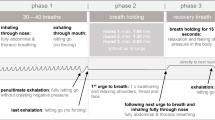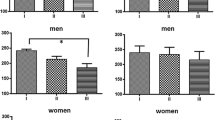Abstract
Systolic blood pressure (SBP), diastolic blood pressure (DBP), and heart rate (HR) reactivity to mental arithmetic and deep knee bends were monitored in a sample of smokers prior to and 6 months following smoking cessation. There was no reduction in cardiovascular reactivity to either stressor following cessation. However, heightened pretreatment DBP and HR reactivity to mental arithmetic and SBP reactivity to deep knee bends were associated with relapse by the 6-month follow-up. Demographic and smoking history variables and pretreatment nicotine dependence were not associated with treatment outcome. Further exploration of cardiovascular reactivity to stress among smokers may elucidate the process of relapse.
Similar content being viewed by others
References
Abrams, D. B., Monti, P. M., Pinto, R. P., Elder, J. P., Brown, R. A., and Jacobus, S. I. (1987). Psychosocial stress and coping in smokers who relapse or quit.Health Psychol. 6(4): 289–303.
Abrams, D. B., Monti, P. M., Carey, K. B., Pinto, R. P., and Jacobus, S. I. (1988). Reactivity to smoking cues and relapse; Two studies of discriminative validity.Behav. Res. Ther. 26(3): 225–233.
Atherosclerosis Study Group (1984). Optimal resources for primary prevention to atherosclerotic diseases.Circulation 70: 155–205.
Benjamin, L. S. (1967). Facts and artifacts in using analysis of covariance to “undo” the law of initial values.Psychophysiology 4: 187–206.
Burton, D. (1977). Consistency versus internality as initiators of behavior change.Int. J. Addict. 12: 553–563.
Dembroski, T. M. (1984). Stress-substance interaction and reactivity.Stress, Reactivity and Cardiovascular Disease: Proceedings of the Working Conference, National Heart, Lung, and Blood Institute.
Dembroski, T. M., MacDougall, J. M., Cardozo, S., Ireland, S., and Krug-Fite, J. (1985). Selective cardiovascular effects of stress and cigarette smoking in young females.Health Psychol. 4: 153–167.
Emmons, K. M. (1988).Smoking Cessation and Change in Physiological Functioning, Unpublished doctoral dissertation, State University of New York at Stony Brook.
Emmons, K. M., and Weidner, G. (1988). The effect of cognitive and physical stress on cardiovascular reactivity among smokers and oral contraceptive users.Psychophysiology 25(2): 166–171.
Emmons, K. M., Emont, S. L., Collins, R. L., and Weidner, G. (1988). Relapse prevention broad spectrum treatment for smoking cessation: A comparison of efficacy.J. Substance Abuse 1: 79–89.
Erickson, L. M., Tiffany, S. T., Martin, E. M., and Baker, T. B. (1983). Aversive smoking therapies: A conditioning analysis of therapeutic effectiveness.Behav. Res. Ther. 21: 595–612.
Fagerstrom, K. O. (1978). Measuring degree of physical dependence to tobacco smoking with reference to individualization of treatment.Addict. Behav. 3: 235–241.
Fagerstrom, K. O. (1982). A comparison of psychological and pharmacological treatment in smoking cessation.J. Behav. Med. 5: 343–351.
Goldstein, S., Gordon, J. R., and Marlatt, G. A. (1984). Attributional processes and relapse following smoking cessation. Paper presented at the annual meeting of the American Psychological Association, Toronto, Canada.
Green, D. E. (1979). Patterns of tobacco use in the United States. In Krasnegor, N. A. (ed.),Cigarette Smoking as a Dependence Process, NIDA Research Monograph 23, DHEW, Washington, DC, pp. 44–57.
Hall, S. M., Tunstall, C., Rugg, D., Jones, R. T., and Benowitz, N. (1985). Nicotine gum and behavioral treatment in smoking cessation.J. Consult. Clin. Psychol. 53: 256–258.
Kozlowski, L. (1979). Psychosocial influences on cigarette smoking. In Krasnegor, N. A. (ed.),The Behavioral Aspects of Smoking, NIDA Research Monograph 26, DHEW, Public Health Service, Washington, DC, pp. 97–126.
Lando, H. A. (1977). Successful treatment of smokers with a broad-spectrum behavioral approach.J. Consult. Clin. Psychol. 45: 361–366.
Lando, H. A., and McGovern, P. (1982). Three-year data on a behavioral treatment for smoking: A follow-up note.Addict. Behav. 4: 177–181.
Lichtenstein, E. (1982). The smoking problem: A behavioral perspective.J. Consult. Clin. Psychol. 50(6): 804–819.
Lichtenstein, E., and Keutzer, C. S. (1967). Further normative and correlational data on the internal-external (I-E) control of reinforcement scale.Psychol. Rep. 21: 1014–1016.
Marlatt, G. A., and Gordon, J. R. (1980). Determinants of relapse: Implications for the maintenance of behavior change. In Davidson, P. O. and Davidson, S. M. (eds.),Behavioral Medicine: Changing Health Lifestyles, Bruner/Mazel, New York, pp. 410–452.
Matthews, K. A., Weiss, S. M., Detre, T., Dembroski, T. M., Falkner, B., Manuck, S. B., and Williams, R. B. (1986).Handbook of Stress, Reactivity, and Cardiovascular Disease, John Wiley & Sons, New York.
Myrston, A. L., Elgerot, A., and Edgren, B. (1977). Effects of abstinence from tobacco smoking on physiological and psychological arousal levels in habitual smokers.Psychosom. Med. 39(1): 25–38.
Niaura, R., Abrams, D., DeMuth, B., Monti, P., and Pinto, R. (1989). Responses to smoking-related stimuli and early relapse to smoking.Addict. Behav. (in press).
Norusis, M. J. (1988). SPSS/PC+. Advanced Statistics V2.0, SPSS, Chicago.
Ohlin, P., Lundh, B., and Westling, H. (1976). Carbon monoxide blood levels and reported cessation of smoking.Psychopharmacology 49: 263–265.
Pechacek, T. F., Fox, B. H., Murray, D. M., and Luepker, R. V. (1984). Review of techniques for measurement of smoking behavior. In Matarazzo, J., Weiss, S., Herd, J. Miller, N., and Weiss, S. (eds.),Behavioral Health: A Handbook of Health Enhancement and Disease Prevention, John Wiley & Sons, New York, pp. 728–754.
Petersen, S. B. (1960). Muscle training by static, concentric, eccentric contraction.Acta Physiol. Scand. 48: 406–416.
Srole, L., and Fischer, A. K. (1973). Smoking behavior between 1953 and 1970: The midtown Manhattan study. In Dunn, W. L., Jr. (ed.),Smoking Behavior: Motives and Incentives, V. H. Winston & Sons, Washington, DC, pp. 255–265.
Straits, B. C. (1967). The discontinuation of cigarette smoking: A multiple discriminant analysis. In Zagona, S. V. (ed.),Studies and Issues in Smoking Behavior, University of Arizona Press, Tucson, pp. 79–81.
Tuttle, W. W., and Dickenson, R. E. (1938). A simplification of the pulse-ratio technique for rating physical efficiency and present condition.Res. Q. 9: 73–80.
USDHHS (1979).Smoking and Health: A Report of the Surgeon General, USDHEW Publication Number (PHS) 79-50066, Department of Health and Human Services, Office on Smoking and Health, Rockville, MD.
USDHHS (1983).The Health Consequences of Smoking: Cardiovascular Disease, Publication Number (PHS) 84-50204, Department of Health and Human Services, Office on Smoking and Health, Rockville, MD.
Wilder, J. F. (1969).Stimulus and Response: The Law of Initial Values, Williams & Wilkins, Baltimore.
Author information
Authors and Affiliations
Additional information
This research was supported by funds from the American Lung Association (Nassau-Suffolk County, NY), the American Heart Association (Suffolk County), the Veteran's Administration, NIH Grants HL3142903, HL3426103, HL4036801, and CA 50108-02, Biomedical Research Support Grants RR0706721 and RR0536927, and Sigma Xi.
Rights and permissions
About this article
Cite this article
Emmons, K.M., Weidner, G. & Collins, R.L. Smoking cessation and cardiovascular reactivity to stress. J Behav Med 12, 587–598 (1989). https://doi.org/10.1007/BF00844827
Accepted:
Issue Date:
DOI: https://doi.org/10.1007/BF00844827




